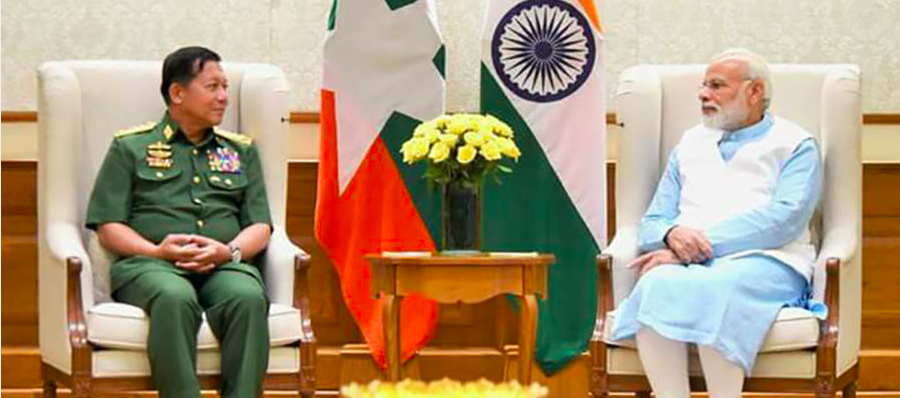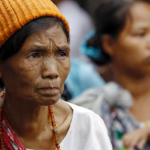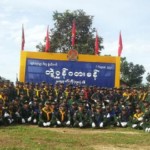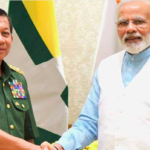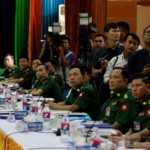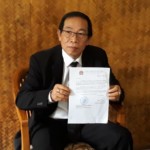By Aung Law / The Irrawaddy | July 21, 2017
New Delhi is seriously considering courting Myanmar, so as to counter China’s influence as well as to urge its leaders to look into the insurgency along the India-Myanmar border.
A substantive package, indicating a deepening relationship, was put forward during Myanmar Army chief Snr-Gen Min Aung Hlaing’s eight-day visit to India.
India provided red carpet treatment for the army chief’s entourage. Prime Minister Narendra Modi received the senior general and the two countries agreed to strengthen defense cooperation. The outcomes of the trip appeared to be extensive.
PM Modi told Snr-Gen Min Aung Hlaing that his country was “a key pillar” of India’s “Act East” policy, the Times of India reported. The Indian PM expressed his “firm commitment” to strengthening bilateral ties with Myanmar, and Min Aung Hlaing received briefings on India’s security perspectives and on Indo-Myanmar defense cooperation, the report said.
India agreed to sell weapons and ammunition to Myanmar. In the past, India also provided artillery guns, rocket launchers, rifles, radars, mortars, bailey bridges, communication gear, night-vision devices, war-gaming software and road construction equipment as well as naval gun-boats, sonars, acoustic domes and directing gear, The Times of India reported on July 8.
During the recent trip, the two sides reportedly agreed that New Delhi would train Myanmar Army officers and allow them to study in military academies in India. Similar trainings and studies have been provided for Myanmar military officials in Russia.
India also agreed to dispatch warships that would make regular calls at ports in Myanmar, in addition engaging in joint military exercises.
Sources close to the military told The Irrawaddy that during the visit, Myanmar expressed a desire to buy helicopter gunships from India, but it is not confirmed whether New Delhi agreed to provide them to its eastern neighbor.
According to an article published in the Asia Times in April, Myanmar’s air force has at least nine Russian-made Mi-35 Hind helicopter gunships, and one dozen Mi-17 transport helicopters.
The report, by longtime journalist Bertil Lintner, stated that in July 2016, an air force delegation led by Gen Khin Aung Myint had traveled to a Russian helicopter plant with the hope of buying upgraded Mi-17V5 helicopters “that would likely be used to attack ethnic armed groups in the north and northeast.”
If India decided to sell such helicopter gunships to Myanmar, they would likely be seen hovering over non-state armed groups along the northern border with China, where daily clashes continue to occur.
In any case, any amount of increased defense cooperation between India and Myanmar will upset China, as military assistance to Myanmar will be seen as New Delhi’s counter to Chinese influence. It could also decrease Myanmar’s reliance on its northern neighbor.
Interestingly, the eight-day trip took place while India and China were caught in a dispute along the border shared by the northeastern Indian state of Sikkim, the Himalayan kingdom of Bhutan, and Tibet. India, a close ally of Bhutan, backed its claim over a plateau, which China says falls within its own territory. Both India and China have reinforced troops in what has turned into a weeks-long standoff.
India and Myanmar also agreed to engage in intelligence cooperation as New Delhi is likely to be closely watching the reported movement of Muslim militants along the border between Bangladesh and northern Rakhine State. There is great concern among top Myanmar leaders, including State Counselor Daw Aung San Suu Kyi that the situation in the region poses a serious security threat.
New Delhi also requested that Snr-Gen Min Aung Hlaing look into the insurgency taking place along the India-Myanmar border, and New Delhi is reportedly concerned that several non-state armed groups could be seeking refuge in Myanmar.
Rebel groups seeking to establish a sovereign territory in the area are active along parts of the 1,640-kilometer border between India and Myanmar.
Observers speculate that in the coming months, India and Myanmar may conduct a joint military operation in the area as the countries did in 2015.
Ethnic Naga and Manipuri rebels are based along the Chindwin River, north of Hkamti Township in Sagaing Region. One of the most well known organizations is the United Liberation Front of Asom
Bertil Lintner wrote in The Irrawaddy in November 2014, “Obtaining weapons there does not seem to be a problem. Beijing appears to reason that if India can shelter one of its main enemies, the Dalai Lama, then Barua is welcome to stay in China.”
Myanmar generals have long fought the rebels backed by China along the border and they have often displayed their distrust toward China.
Flanked between China and India, strategically Myanmar could benefit from two giant neighbors and maintain a stable border. But the two players are not at peace—they are, in fact, geopolitical and economic rivals.
As Myanmar’s armed forces under Snr-Gen Min Aung Hlaing step up to deepen defense cooperation with New Delhi, China will no doubt take notice.
This article originally appeared on The Irrawaddy on July 21, 2017.

